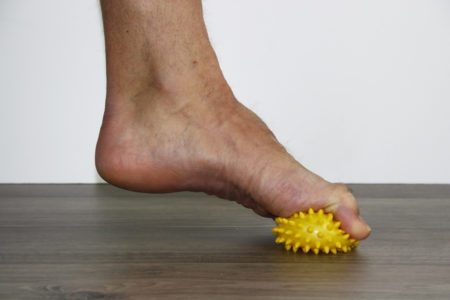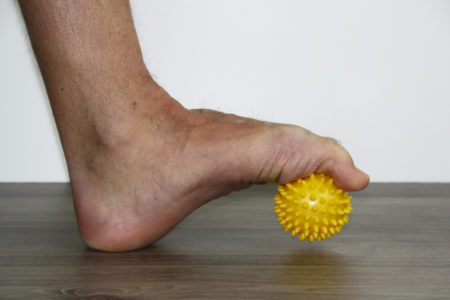Increasing Intrinsic Foot Muscle Strength

For a long time, the plantar fascia (aponeurosis) has been given a leading role as ‘the’ soft tissue for maintaining the foot’s profile in gait and for stiffening the foot during the stance phase through the windlass mechanism (1; 2). More recently researchers have taken a harder look a the plantar intrinsics to see how significant their role is in foot function (3). Our intent is this short article is to answer the question; ‘is intrinsic foot muscle strength important?’
Here at HealthyStep® we have long promoted foot rehabilitation as an integral part of foot orthosis design and provision, both for the intrinsic and extrinsic foot muscles and lower limb generally. The foot therapy ball, which is proven to assist in generating higher digital pressures in gait after only 6 weeks use (4), is one of several exercises available on videos linked to our website that offer patients simple yet effective forms of rehabilitation.
We know the plantar intrinsic are important, and here briefly is why. The intrinsics are suggested to be important in supporting the medial long arch in conjunction with the plantar fascia (5; 6), and in so reducing the stress on the plantar fascia (7; 8). However, several studies indicate the plantar intrinsics only play a limited role if any, in the dynamic medial long arch profile changes in gait, assessed through monitoring the changes in navicular drop (3; 8). It would appear that intrinsic activity does some stiffening effect on the foot but not the longitudinal arch (3). The arch reaches its lowest height in gait just before heel lift (9), and rather than limiting the actual drop, increased intrinsic activity results in a later navicular low point in late midstance (8). This probably leaves some ‘extra’ energy-absorbing properties in the arch later into midstance than if navicular drop is early.

With increased activity, plantar intrinsics are able to reduce vertical ground reaction forces in the latter half of stance phase, without reducing the velocity of progression forces that result in power generation in the foot during the propulsive phase of gait (8). That means they are dissipating energy as shock absorbers without the foot losing elastic energy. The foot generates around 8-17% of the energy that used to drive us forward (2;10) at propulsion and that is important in helping to reduce the metabolic costs of walking and running. Intrinsics are able to reduce tissue stress yet allow the foot to retain its important elastic recoil ability. The energy that the intrinsics dissipate is probably achieved through the activity of the muscle-tendon complexes through the stretch-shortening cycle, a well know ‘method’ of ‘energy absorption’ by muscles (11;12).
 In absorbing energy from the vertical ground reaction forces there is less GRF energy to strain the plantar fascia. Therefore, plantar intrinsics may be important for the protection of the plantar aponeurosis. Patients with plantar fasciitis have been shown to have less volume (13) and less cross-sectional area in their intrinsics than plantar fasciitis free age-matched controls (14). This suggests the ability of the intrinsics to absorb energy may be protecting the plantar fascia from higher tensional stresses. It appears that stronger, larger intrinsic foot muscles may result in stiffer longitudinal arches, as this is found in those who habitually use minimal footwear (15).
In absorbing energy from the vertical ground reaction forces there is less GRF energy to strain the plantar fascia. Therefore, plantar intrinsics may be important for the protection of the plantar aponeurosis. Patients with plantar fasciitis have been shown to have less volume (13) and less cross-sectional area in their intrinsics than plantar fasciitis free age-matched controls (14). This suggests the ability of the intrinsics to absorb energy may be protecting the plantar fascia from higher tensional stresses. It appears that stronger, larger intrinsic foot muscles may result in stiffer longitudinal arches, as this is found in those who habitually use minimal footwear (15).
Although not directly influencing the longitudinal arch height, plantar intrinsic play an important role in stiffening the forefoot and stabilising the metatarsal phalangeal joints during the terminal part of stance phase, when it is essential that the power generated at the ankle are converted into large ground reaction forces through a stiff foot acting as a lever to propel forward on (3; 8). Abductor hallucis and quadratus plantae may also play a role in activating the reverse windlass effect before initial heel contact as both these muscles are active in terminal swing and into early stance phase (16), giving them a potential role in impact energy dissipation.
We have only listed here some of the roles of the plantar intrinsic muscles, there are actually quite a few more. So the answer is….. YES!
The plantar intrinsics are very important, so don’t let anyone tell you otherwise.
References:
- Hicks JH. (1954). The mechanics of the foot: II. The Plantar aponeurosis and the arch. J Anatomy. 88: 25-30.
- Ker LRF, Bennett MB, Bibby SR, Kester RC, Alexander RMcN. (1987). The spring in the human foot. Nature. 325: 147-149.
- Farris DJ, Kelly LA, Cresswell AG, Lichtwark GA.(2019). The functional importance of human foot muscles for bipedal locomotion. PNAS. 116: 1645-1650.
- Branthwaite H, Grabtree G, Chockalingam N, Greenhalgh A. (2018). The effect of toe flexion exercises on grip. J. Am. Podiatr. Med. Assoc. 108: 355-361.
- Wong YS. (2007). Influence of the abductor hallucis muscle on the medial arch of the foot: a kinematic and anatomical cadaver study. Foot Ankle Int. 28: 617-620.
- Kelly LA, Cresswell AG, Racinais S, Whiteley R, Lichtwark G. (2014). Intrinsic foot muscles have the capacity to control deformation of the longitudinal arch. J. R. Soc. Interface. 11: 20131188.
- Wu I (2007). Nonlinear finite element analysis for musculoskeletal biomechanics of medial and lateral longitudinal arch of virtual Chinese humans after plantar ligament structural failure. Clin. Biomech. 22: 221-229.
- Okamura K, Kanai S, Hasegawa M, Otsuka A, Oki S. (2018). The effects of additional activation of the plantar intrinsic foot muscles on foot dynamics during gait. Foot. 34: 1-5.
- Hunt AE, Smith RM, Torode M, Keenan A-M. (2001). Inter-segment foot motion and ground reaction forces over the stance phase of walking. Clin. Biomech. 16: 592-600.
- Stearne SM, McDonald KA, Alderson JA, North I, Oxnard CE, Rubensen J. (2016). The foot arch and the energetics of human locomotion. Scientific Rep. 6: 19403.
- Roberts TJ, Azizi E. (2010). The series-elastic shock absorber: tendons attenuate muscle power during eccentric actions. J App Physio. 109: 369-404.
- Roberts TJ, Konow N. (2013). How tendon buffer energy dissipation by muscle. Exerc. Sports Sci. Rev. 41: 186-193.
- Pohl MB, Hamill J, Davis IS. (2009). Biomechanical and anatomical factors associated with a history of plantar fasciitis in female runners. Clin. J. Sports Med. 19: 372-376.
- Angin S, Crofts G, Mickle KJ, Nester CJ. (2014). Ultrasound evaluation of foot muscles and plantar fascia in pes planus. Gait Posture 40: 48-52.
- Holowka NB, Wallace IJ, Lieberman DE. (2018). Foot strength and stiffness are related to footwear use in a comparison of minimally- vs conventionally-shod populations. Sci Rep. 8:3679.
- Kelly LA, Cresswell AG, Racinais S, et al. (2015). Active regulation of the longitudinal arch compression and recoil during walking and running. J. R. Soc. Interface. 12: 20141076.
